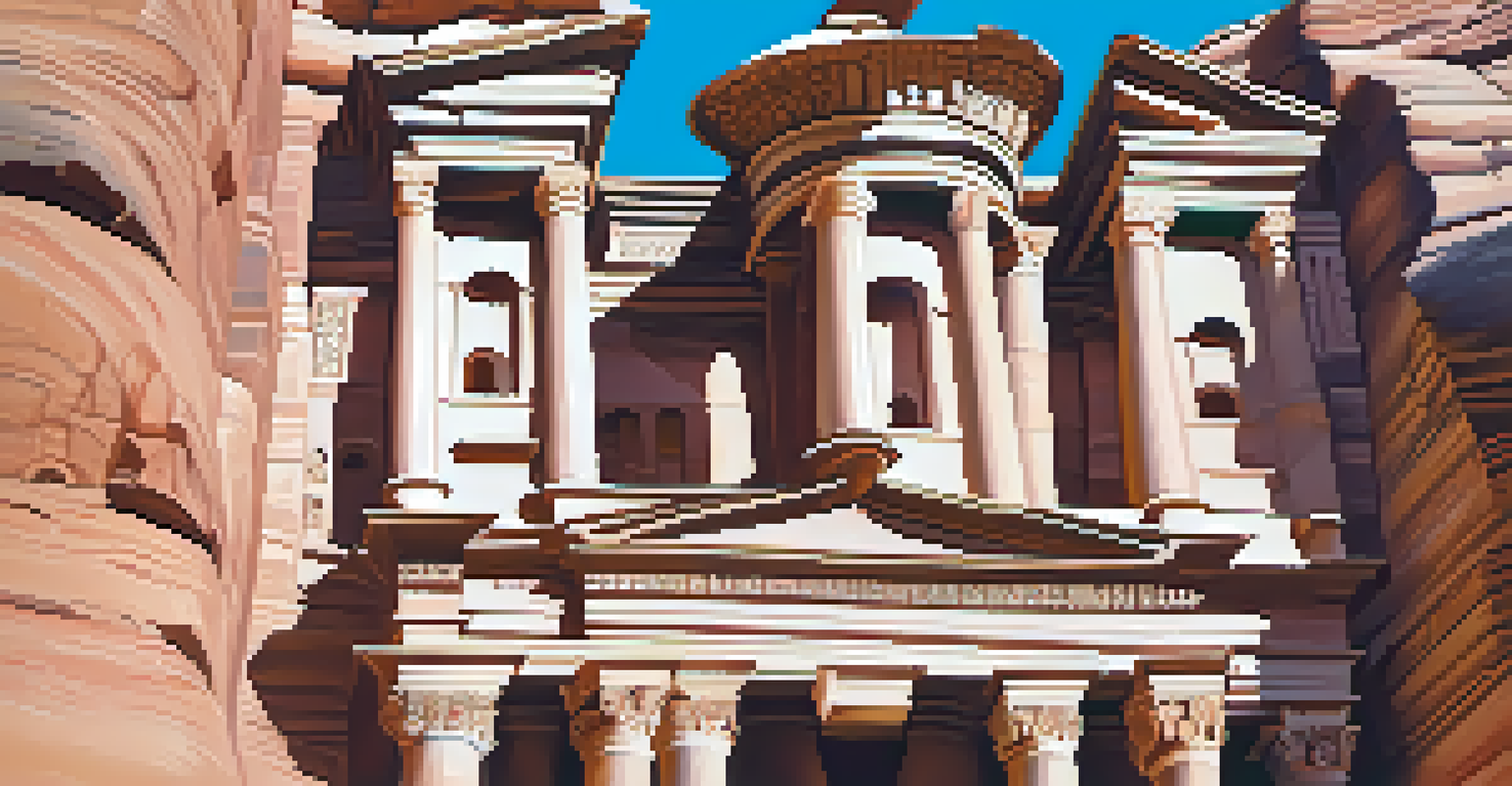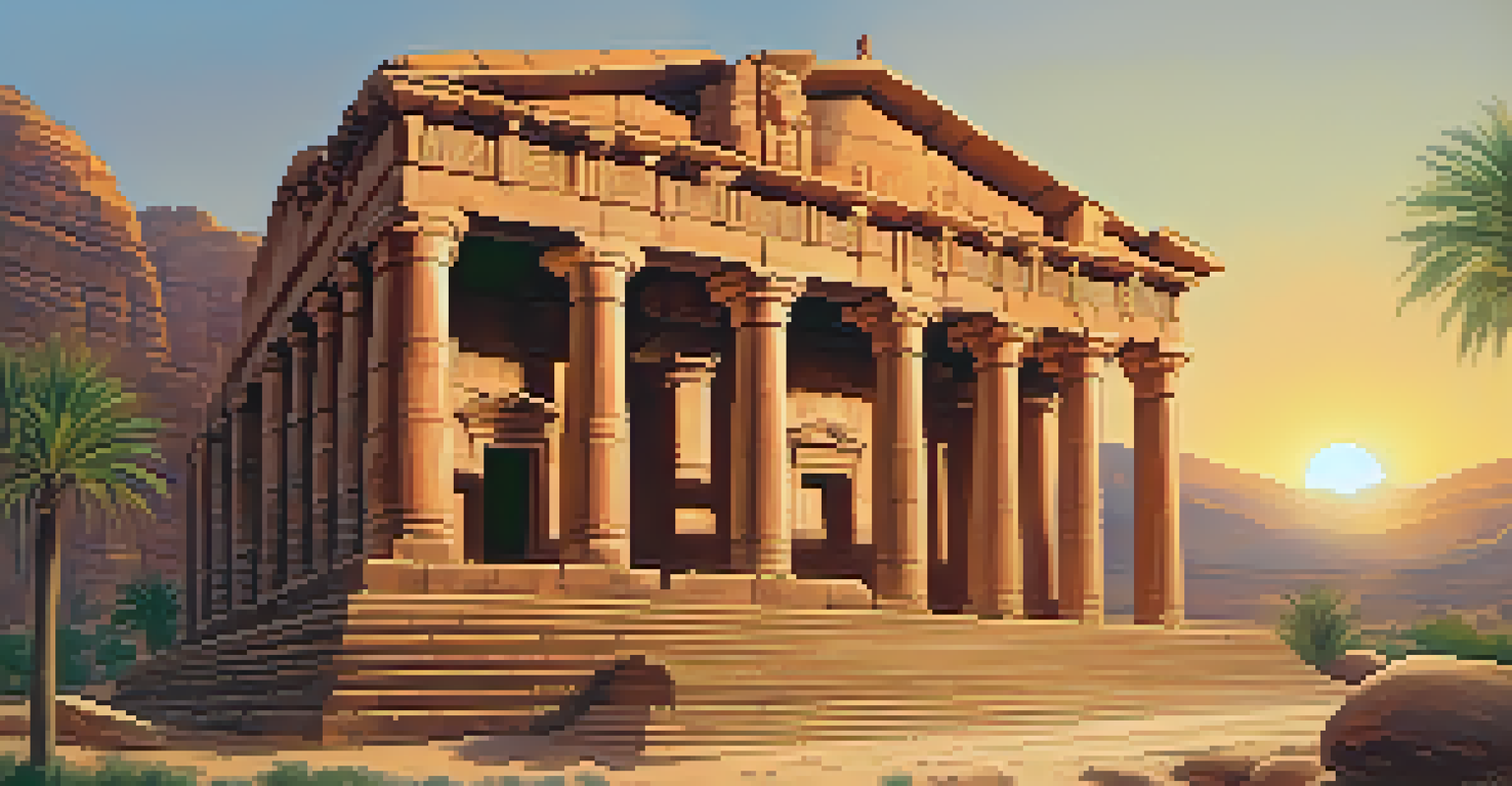The Ancient City of Petra: A Treasure of Nabataean Culture

Introduction to Petra: A Jewel of the Desert
Nestled in the rugged mountains of southern Jordan lies Petra, one of the most significant archaeological sites in the world. Known as the 'Rose City' for its stunning pink sandstone cliffs, Petra was once the thriving capital of the Nabataean Kingdom. This ancient city is not just a feast for the eyes; it tells the story of a civilization that excelled in trade, architecture, and water management.
Petra is a place that inspires awe, a testament to human ingenuity, and a reminder of the past's beauty.
The Nabataeans, who inhabited Petra from around the 4th century BC, were master traders who carved their lives into the rock itself. They transformed this arid landscape into a bustling hub, connecting trade routes from Arabia to the Mediterranean. Today, Petra stands as a testament to their ingenuity and resourcefulness in overcoming the natural challenges of the region.
As we embark on this journey through Petra, we will explore its history, architecture, and cultural significance, painting a vivid picture of this remarkable city that has captivated travelers for centuries.
The Nabataeans: Architects of a Thriving Trade Empire
The Nabataeans were not only skilled traders; they were also brilliant architects and engineers. They developed a sophisticated water management system that included cisterns, canals, and water conduits, allowing them to thrive in the arid environment. This ingenuity enabled them to support their population and sustain trade, transforming Petra into a bustling metropolis.

The city's strategic location along major trade routes made it a melting pot of cultures, where ideas, goods, and traditions intersected. The Nabataeans deftly blended influences from various civilizations, including the Greeks and Egyptians, which is evident in their unique architectural styles. From intricate carvings to monumental tombs, the artistry of Petra reflects a rich cultural tapestry.
Petra: An Architectural Marvel
Petra's stunning structures, like Al-Khazneh and the Monastery, showcase the Nabataeans' extraordinary craftsmanship and blend of cultural influences.
Ultimately, the Nabataeans’ understanding of commerce and architecture helped them establish a lasting legacy, making Petra a vital player in the ancient world and a cornerstone of their culture.
Petra's Architectural Wonders: A Visual Symphony
One of Petra's most iconic structures is Al-Khazneh, also known as the Treasury. This grand facade, carved directly into the rose-colored rock, stands nearly 40 meters high and features intricate details that showcase the Nabataeans' craftsmanship. Travelers often find themselves awestruck by its beauty, and it serves as a powerful symbol of Petra's architectural ingenuity.
The treasures of Petra are not just found in its architecture, but in the stories it tells about a civilization that thrived against the odds.
Beyond the Treasury, Petra is home to numerous other remarkable structures, including the Monastery (Ad Deir) and the Roman-style theater. Each building tells a story, revealing the complex social and religious life of the Nabataeans. The blend of Hellenistic and Eastern architectural elements reflects the city's diverse influences and highlights the creativity of its builders.
As you wander through the narrow canyons, or Siqs, leading to these monuments, you can't help but feel the weight of history surrounding you. Each step brings you closer to understanding the artistry and vision that shaped this ancient city.
The Role of Religion in Nabataean Society
Religion played a central role in the lives of the Nabataeans, influencing their daily routines and architectural choices. They practiced a polytheistic belief system, worshipping various deities associated with nature and fertility. Temples and altars dedicated to these gods can still be found in Petra, providing insight into the spiritual practices of this ancient civilization.
The most significant religious site in Petra is the Temple of the Winged Lions, which reflects the Nabataeans' reverence for their deities. This temple features unique architectural elements, blending local styles with Hellenistic influences. Such religious structures not only served as places of worship but also as centers for community gatherings and celebrations.
Nabataean Trade and Legacy
The Nabataeans transformed Petra into a bustling trade hub by expertly managing water resources and connecting vital trade routes.
The intertwining of religion and daily life made Petra a vibrant spiritual hub, where rituals and festivities helped strengthen social bonds and preserve cultural identity. The remnants of these practices continue to fascinate archaeologists and visitors alike.
Petra's Decline: The Impact of Changing Trade Routes
Despite its flourishing trade, Petra faced challenges that eventually led to its decline. In the 2nd century AD, new trade routes emerged, bypassing the city and significantly reducing its economic importance. This shift marked the beginning of a slow decline for the once-thriving metropolis, as the Nabataeans struggled to maintain their influence.
Natural disasters, such as earthquakes, further contributed to the city's downfall. These events damaged Petra's infrastructure and disrupted the water management systems that were crucial for its survival. As the population dwindled, the once-bustling trade hub faded into obscurity, leaving behind a haunting yet beautiful ghost town.
The decline of Petra serves as a reminder of how interconnected economies and environments can dramatically change the fate of civilizations. Despite its fall, the city's legacy endures, attracting visitors from around the globe who seek to uncover its storied past.
Rediscovery of Petra: A Journey Through Time
For centuries, Petra remained hidden from the outside world, known only to the local Bedouins. It wasn't until 1812 that Swiss explorer Johann Ludwig Burckhardt brought it to global attention. His adventurous journey into the heart of the city sparked interest among scholars and travelers, leading to a renewed fascination with this ancient site.
Following Burckhardt's rediscovery, Petra became a focal point for archaeologists and historians eager to explore its secrets. Excavations revealed remarkable structures, artifacts, and inscriptions that provided insights into the Nabataean culture and daily life. This ongoing research continues to deepen our understanding of Petra's history and significance.
Rediscovery Sparks Global Interest
The rediscovery of Petra in 1812 by Johann Ludwig Burckhardt reignited interest in this ancient site, leading to its recognition as a UNESCO World Heritage Site.
Today, Petra is recognized as a UNESCO World Heritage Site and is one of the New Seven Wonders of the World. The journey of rediscovery has transformed it into a symbol of resilience and a testament to human creativity, inspiring countless visitors to marvel at its beauty.
Visiting Petra: Tips for the Modern Traveler
Planning a visit to Petra is an adventure in itself, as the site offers a wealth of experiences for every type of traveler. Start by arriving early to beat the crowds and catch the sunrise illuminating the rose-colored rock formations. The main entrance leads you through the dramatic Siq, an awe-inspiring gorge that sets the stage for the wonders ahead.
Don't forget to wear comfortable shoes, as exploring Petra involves significant walking and some uphill climbs. Be sure to bring plenty of water and snacks, as the desert climate can be demanding. For those seeking a more in-depth experience, consider hiring a local guide who can share fascinating stories and insights about the city's history.

Finally, take your time to soak in the breathtaking views and capture unforgettable memories. Whether you're admiring the grandeur of the Treasury or enjoying the tranquility of the surrounding landscapes, Petra promises a unique and enriching experience that will stay with you long after your visit.